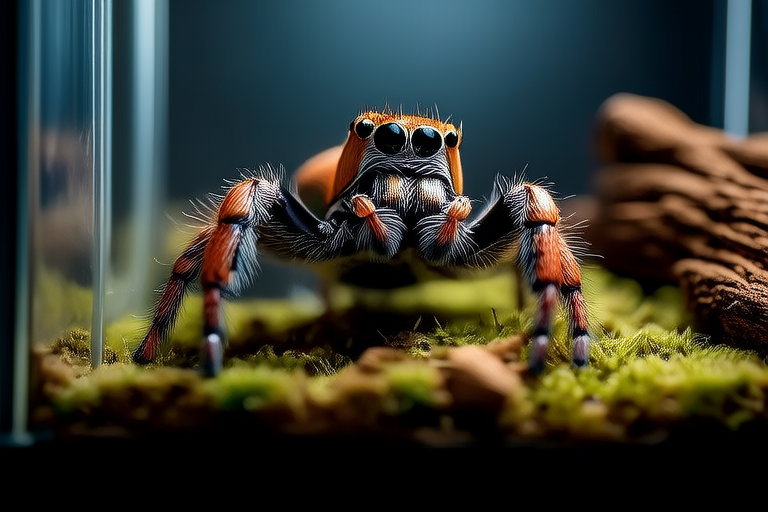From Fear to Fascination: Raising Awareness About Tarantula Ownership
When most people think of tarantulas, they imagine large, hairy spiders with venomous fangs lurking in dark corners. While it’s true that tarantulas can be intimidating at first glance, these misunderstood arachnids are actually fascinating creatures that make wonderful pets for the right owner. In this article, we will explore the world of tarantulas, dispel common myths, provide essential care tips, and share personal stories that highlight the unique charm of these eight-legged wonders.
The Unique World of Tarantulas
Tarantulas belong to the family Theraphosidae and are found on every continent except Antarctica. With over 900 species, these spiders come in a variety of sizes, colors, and temperaments. The largest tarantula species is the Goliath birdeater (Theraphosa blondi), which can reach up to 11 inches in leg span and weigh around 6 ounces. On the other hand, the smallest tarantula species is the Colombian lesser black tarantula (Aphonopelma colubris), with a leg span of just 2 inches.
One of the most intriguing aspects of tarantulas is their defensive behavior. When threatened, many species of tarantulas will flick urticating hairs from their abdomen as a defense mechanism. These tiny barbed hairs can cause irritation to the eyes and skin of predators, making them an effective deterrent. Some species, like the Chilean rose tarantula (Grammostola rosea), have bright pink or red hairs, adding to their striking appearance.
Busting Common Misconceptions
Many people associate tarantulas with aggressive, venomous behavior. However, most tarantulas are docile and pose little threat to humans. Their venom is generally mild, comparable to a bee sting, and is primarily used to subdue prey rather than defend against larger animals. In fact, only a few tarantula species have venom strong enough to cause serious health issues in humans, and even then, reactions are usually mild.
Another misconception is that all tarantulas live in dark, dank caves. While some species do prefer underground burrows, many others thrive in trees or under rocks. For example, the pinktoe tarantula (Avicularia avicularia) is an arboreal species that lives in trees in its natural habitat. They have long legs and are excellent climbers, often hanging upside down by their front legs to catch prey.
Essential Care Tips for Tarantula Owners
Before considering a tarantula as a pet, it’s crucial to understand the specific needs of your chosen species. Here are some general guidelines to help you create a comfortable and safe environment for your new friend:
- Housing: Provide a spacious terrarium with a secure lid to prevent escapes. The enclosure should be at least three times the length of the tarantula’s leg span. Line the bottom with coconut fiber or similar substrate that retains moisture and allows burrowing.
- Temperature and Humidity: Maintain a temperature between 75°F and 85°F (24°C to 29°C) and humidity levels appropriate for your tarantula’s species. Most terrestrial species prefer humidity levels between 60% and 80%, while arboreal species may require higher humidity.
- Diet: Feed your tarantula appropriately sized crickets, mealworms, or dubia roaches. Young tarantulas should be fed every 3-5 days, while adults can be fed less frequently, depending on their size.
- Handling: Handle your tarantula carefully, if at all. Many species are skittish and may react defensively if mishandled. Always support the spider’s body when handling to avoid injuring it.
Personal Stories and Scientific Insights
One of the most compelling reasons to appreciate tarantulas is their unique behaviors and interactions with their environment. For instance, the Mexican redknee tarantula (Brachypelma smithi) has been studied extensively for its remarkable ability to learn and adapt to new situations. Researchers have found that these spiders can solve complex mazes and remember the location of food sources, demonstrating impressive problem-solving skills.
Another fascinating aspect of tarantula biology is their molting process. As tarantulas grow, they shed their exoskeletons in a process called ecdysis. During this time, they are extremely vulnerable and should not be disturbed. The process can take several hours, during which the tarantula remains still and weak. After molting, the spider will often eat its old exoskeleton for nutrients.
Personal stories from experienced tarantula owners also offer valuable insights into the joys of owning these creatures. Many owners describe the calming effect of watching their tarantulas hunt and interact with their environment. One owner shared, “My tarantula is like a living sculpture. It’s mesmerizing to watch her weave her web and wait patiently for prey. There’s something incredibly peaceful about her presence.”
Responsible Ownership and Conservation
While tarantulas can make rewarding pets, it’s important to approach ownership responsibly. Always purchase your tarantula from a reputable breeder or rescue organization to avoid supporting the illegal wildlife trade. Additionally, ensure that the species you choose is suitable for your lifestyle and experience level.
Conservation efforts are also crucial for protecting wild tarantula populations. Habitat destruction and over-collection for the pet trade have put many species at risk. By choosing captive-bred specimens and supporting conservation initiatives, you can help ensure the survival of these amazing creatures.
Conclusion
From their fascinating behaviors to their unique physical characteristics, tarantulas offer a wealth of educational opportunities and entertainment for those willing to look beyond the initial fear. By providing proper care and respect, you can enjoy a rewarding relationship with these incredible arachnids. Remember, the journey from fear to fascination is well worth the effort, and you’ll be rewarded with a truly special companion.
